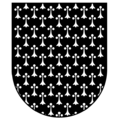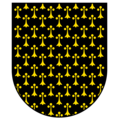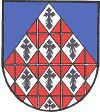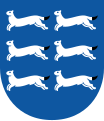Ermine (heraldry)
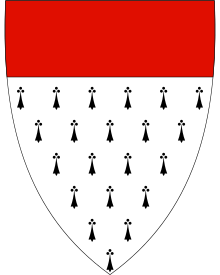
Ermine , the representation of the ermine , is used in various forms in heraldry .
Ermine fur
As a stylized heraldic fur of the animal of the same name, it is one of the heraldic tinctures . The origin is seen in the nailed coat of arms with real fur in the early days of heraldry. This form was a substitute for a coat of arms. The literature documents that the minstrel Ulrich von Lichtenstein wielded such a covered shield. Dated around 1200/1275 or 1276.
It is shown in the form of small black crosses arranged in rows on a white (silver) background. This refers to the fact that the small black tail tips are distributed in the white ermine fur (ermine tails) . This differs from the Feh , in which the different fields are each of similar size.
In the stylized way as fur, it has found its distribution, especially in English heraldry. Ermine is always black tails on silver , otherwise it has its own name: Like the lilies in French coats of arms (lily hermelin) , ermine is the counterpart on the English coat of arms . The gold hermelin and counter hermelin have established themselves here . In English heraldry, it is referred to as pean . The golden tails are shown on a black background. Conversely, it is emblazoned as erminoys .
Ermine
( Brittany )
Special shapes also have their own names. So the bar covered with the ermine is an ermine bar . This has its spread in the English heraldry. The fur-covered cross is also used , albeit rarely, in heraldry as an ermine cross .
Two ermine rafters ( Eppenstein DE)
Lozenges made of ermine ( Hofkirchen bH AT)
The ermine in natural representation
Ermine has been preserved in a natural representation on the coat of arms and the coat of arms . In this form, it is also used as a heraldic animal on heraldic shields . So it's a mean figure . Thus it can also appear as a helmet ornament . Hats are often adorned with it on the forend. The Kurhut is an example. But the feeding of crowns, which is visible from the outside, is often actually equipped with it.
In heraldry, the real and stylized ermine shape is in use. An example of this is the ducal hat .
There are also coats of arms depicting small ermine tails on the furrier . This is then an ermine curry . In particular, the stylized ermine tail can also be viewed as a common figure. There are several tails in the shield without touching the edge of the shield or being cut by it.
Crown with ermine trim ( Archduke's Crown of Austria)
In natural representation as heraldic animal ( Pohjois-Pohjanmaan FI)
See also
literature
- Gert Oswald : Lexicon of Heraldry . VEB Bibliographisches Institut, Leipzig 1984, ISBN 3-411-02149-7 .
Web links
- Ermine (Heraldry) in the Heraldry Wiki


